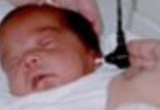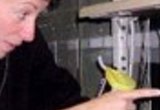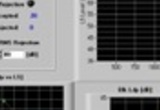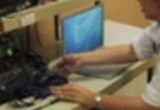Carolina Abdala
Professor of Otolaryngology
Keck School of Medicine
University of Southern California
Research Topics
- The maturation and aging of cochlear function in humans and the mechanisms driving age-related change.
- Development of an SFOAE-DPOAE Joint profile for differential diagnosis of hearing loss
- Generation mechanisms of otoacoustic emissions
Research Overview
Human Cochlear Function: A Continuum of Maturation and Aging.This project studies changes in cochlear function throughout the human lifespan, defining the timeline for these age-related shifts and the mechanisms driving the changes. We use primarily otoacaoustic emissions, a noninvasive probe of cochlear mechanics to learn about the human peripheral system. We apply both distortion- (DPOAE) and reflection-source (stimulus frequency OAEs and the reflection-component of the DPOAE) emissions using custom-algorithms, innovative swept-tone methodology and advanced analysis schemes. We disentangle the origin of age-related effects by separating distortion product OAEs into their dual components, distortion and reflection; and studying how each components phase and amplitude is impacted throughout the human lifespan. In our lab it is important to study both apical and basal halves of the cochlea to yield a more comprehensive understanding of mechanics. The apex has been minimally studied in humans, and wholly unexplored during maturation. Yet, we have recently reported striking immaturities in DPOAE phase for low-frequency signals coded in the apex of neonates. Our exploration of human cochlear function from base to apex using multiple OAE sources establishes a normative framework, provides detailed information about how the newborn cochlea works and how the elderly cochlea ages. This information contributes to more comprehensive cochlear models and toward the development of more innovative probes of cochlear mechanics for human application. This project is funded by the NIH-NICCD.
Advanced Detection and Differential Diagnosis of Hearing Loss using Otoacoustic Emissions.
This project uses novel methodologies and analyses techniques to measure and exploit the distinct information embedded in reflection- and distortion-source OAEs and create a more comprehensive and descriptive assessment of cochlear function and dysfunction. At present, OAEs are used in a categorical sense, simply to detect hearing loss. However, the ample information offer by each OAE-source (i.e. linear reflection and nonlinear distortion) provides distinct clues about hearing and hearing loss. We wish to exploit this distinct information to describe and distinguish among sensorineural hearing losses (SNHL) of differing etiologies. At present, SNHL is a catch-all term, defined by degree of loss and audiometric configuration. However, two hearing losses with identical audiograms can produce varying perceptual difficulties and varied success with hearing aids. By recording reflection and distortion emissions together over a broad parametric space, we will learn more about the underlying deficits that make up the broad category of SNHL. When used in combination, the properties embodied by each emission source can are considered in one joint metric. We are currently developing and testing this joint-OAE profile by recording stimulus frequency OAEs and the distortion component of DPOAEs in ears with hearing loss of differing etiologies such as noise, ototoxic drugs, aging, and genetic factors. Our objective is to detect hearing loss with this joint-profile but more importantly, to perform differential diagnosis so as to appropriately guide intervention. Identifying the underlying basis of a hearing loss will become more critical as pharmaceutical and genetic treatments for hearing dysfunction are developed and established. This work is being done with colleague, Dr. Christopher Shera.
Selected Publications
View a complete Google Scholar search
Meenderink S.W.F., Shera C.A., Valero M.D., Liberman M.C., and Abdala C. “Morphological immaturity of the neonatal organ of Corti and associated structures in humans,” J. Assoc. Res. Otolaryngol. Aug 18, 2019. PMID: 31407107
-PubMedMaxim T., Shera C.A, Charaziak K.K., and Abdala C. “Effects of Forward- and Emitted-Pressure Calibrations on the Variability of Otoacoustic Emission Measurements Across Repeated Probe Fits,” Ear Hear. Mar 14, 2019.
Abdala, C., Ortmann, A., and Shera, C.A. “Reflection and distortion otoacoustic emissions: Evidence for increased irregularity in the human cochlea during aging,” J. Assoc. Res. Otol. 2018.
Abdala, C., Guardia, Y., and Shera, C.A. “Swept-tone stimulus-frequency otoacoustic emissions in normal hearing adults; Normative data and methodological considerations,” J. Acoust. Soc. Am. 143. 2018. PMID:29390734.
Abdala, C., Luo, P., and Shera, C.A. “Characterizing spontaneous otoacoustic emissions across the human lifespan,” J. Acoust Soc. Am. 141, 1874. 2017. PMID: 28372113
Abdala, C., Luo, P., and Shera, C.A. “Optimizing swept-tones to measure DPOAEs in adult and newborn ears,” J. Acoust. Soc. Am. 138, 3785-3799. 2015. PMID 26723333.
Abdala, C., and Kalluri, R. “Towards a joint reflection-distortion otoacoustic emission profile: Results in normal and impaired ears,” J. Acoust. Soc. Am. 142, 812. 2017. PMID:28863614
Abdala, C., and Dhar, S. “Maturation and aging of the human cochlea: A view through the DPOAE looking glass,” J. Assoc. Res. Otolaryngol. 13, 403-421. 2012. PMID: 22476702
Abdala, C., Dhar, S., and Mishra, S. “The breaking of cochlear scaling symmetry in human newborns and adults,” J. Acoust. Soc. Am. 129, 3104-3114. 2011. PMID: 21568413.
Abdala, C., Keefe, D., and Oba, S. “DPOAE suppression tuning in human infants from birth through six months of age,” J. Acoust. Soc. Am. 121, 3617-3627. 2007. PMID: 17552713.






